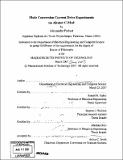| dc.contributor.advisor | Ronald R. Parker. | en_US |
| dc.contributor.author | Parisot, Alexandre, 1979- | en_US |
| dc.contributor.other | Massachusetts Institute of Technology. Dept. of Electrical Engineering and Computer Science. | en_US |
| dc.date.accessioned | 2008-02-27T22:39:25Z | |
| dc.date.available | 2008-02-27T22:39:25Z | |
| dc.date.copyright | 2007 | en_US |
| dc.date.issued | 2007 | en_US |
| dc.identifier.uri | http://hdl.handle.net/1721.1/40505 | |
| dc.description | Thesis (Ph. D.)--Massachusetts Institute of Technology, Dept. of Electrical Engineering and Computer Science, 2007. | en_US |
| dc.description | Includes bibliographical references (p. 189-197). | en_US |
| dc.description.abstract | In tokamak plasmas with multiple ion species, fast magnetosonic waves (FW) in the Ion Cyclotron Range of Frequency can mode convert to shorter wavelength modes at the Ion-Ion hybrid layer, leading to localized electron heating and current drive. Due to k1l upshifts associated with the poloidal magnetic field, only small net driven currents were predicted from mode converted Ion Bernstein Waves (IBW). As studied first by Perkins, and later confirmed experimentally with Phase Contrast Imaging measurements on Alcator C-Mod, poloidal field effects can also lead to mode conversion to Ion Cyclotron Waves (MCICW), on the low field side of the mode conversion layer. In this thesis, mode conversion current drive in the ICW-dominated regime is studied numerically and through experiments on Alcator C-Mod. Solving a dispersion relation for the mode converted waves in a slab geometry relevant to tokamak equilibria and in the finite Larmor radius limit, we find that mode conversion to Ion Cyclotron Waves is ubiquitous to high temperature conventional tokamaks, as a result of the central value for the safety factor qo 1. MCICWs are identified as kinetically modified Ion Cyclotron Waves in the regime w/kllVthe < 1. Full wave simulations with the TORIC code predict net currents can be driven by MCICW as a result of up-down asymmetries in the mode conversion process. Initial estimates with the Ehst-Karney parametrization indicated up to -- 100 kA could be driven for 3 MW input power in C-Mod plasmas. More accurate calculations, consistent with the polarization of MCICWs, were carried out by importing a quasilinear diffusion operator build from the TORIC fields in the Fokker-Planck code DKE, and predicted lower current drive efficiencies by a factor of 2. | en_US |
| dc.description.abstract | (cont.) The TFTR discharges in 1996 where net MCCD currents were inferred experimentally from loop voltage differences were simulated with TORIC, which indicates mode conversion to ICW can account for the driven currents. Similar loop voltage experiments in D(3He) plasmas were attempted on Alcator C-Mod, but did not yield conclusive current drive measurements. The lack of control over Zeff in C-Mod, which is illustrative of ICRF operation in tokamaks with metallic walls, makes reaching optimal plasma conditions for MCCD difficult, and limits the range of parameters in which MCCD can be useful as a net current drive tool in C-Mod. Solving the current diffusion equation in the cylindrical limit and with sawtooth reconnection models, the large sawtooth oscillations in C-Mod plasmas were also found to complicate current relaxation and hinder the loop voltage analysis for small central driven currents inside the q = 1 surface. In separate experiments on Alcator C-Mod, sawtooth period changes were used to infer localized MCCD near the q = 1 surface. The mode conversion layer was swept outward through the q = 1 surface in D(3He) plasmas, and the sawtooth period was found to vary from 3 to 12 ms, which is consistent wih localized current drive and TORIC predictions. A similar evolution was found in heating and co-current drive phasing, which suggests net currents are driven with a symmetric antenna spectrum, as predicted by TORIC as a result of asymmetries in the mode conversion process. Simulations of the sawtooth cycle with the Porcelli trigger model indicate that TORIC currents can account for the sawtooth period evolution in heating phasing. | en_US |
| dc.description.abstract | (cont.) Based on simulations of the saw-tooth cycle with the Porcelli trigger model, localized electron heating, which could also explain the experimental results, was found not to be dominant compared to the current drive effect. The experimental results demonstrate that, while not optimal, MCCD can be used for sawtooth control. | en_US |
| dc.description.statementofresponsibility | by Alexandre Parisot. | en_US |
| dc.format.extent | 197 p. | en_US |
| dc.language.iso | eng | en_US |
| dc.publisher | Massachusetts Institute of Technology | en_US |
| dc.rights | M.I.T. theses are protected by copyright. They may be viewed from this source for any purpose, but reproduction or distribution in any format is prohibited without written permission. See provided URL for inquiries about permission. | en_US |
| dc.rights.uri | http://dspace.mit.edu/handle/1721.1/7582 | |
| dc.subject | Electrical Engineering and Computer Science. | en_US |
| dc.title | Mode conversion current drive experiments on Alcator C-Mod | en_US |
| dc.type | Thesis | en_US |
| dc.description.degree | Ph.D. | en_US |
| dc.contributor.department | Massachusetts Institute of Technology. Department of Electrical Engineering and Computer Science | |
| dc.identifier.oclc | 191825567 | en_US |
